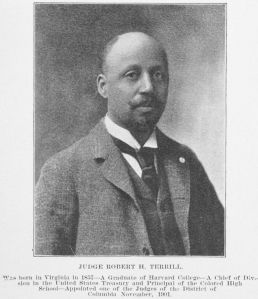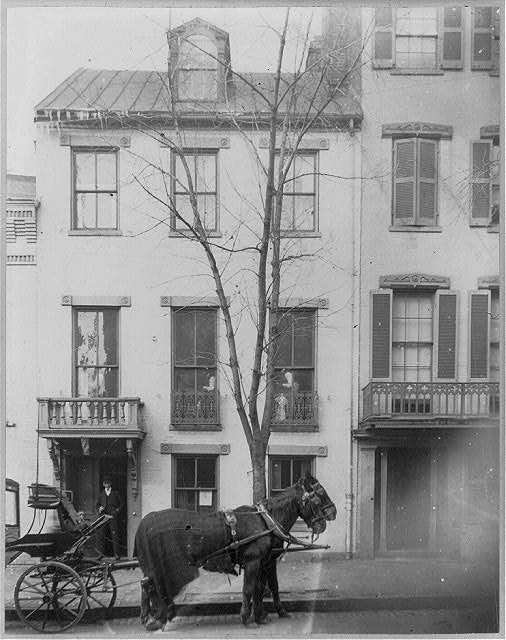Archive for February, 2015
“Colored American,” Washington, D.C.
Posted by jmullerwashingtonsyndicate in Uncategorized on February 26, 2015
The Colored American began publishing in 1893 under the ownership of Edward Elder Cooper, who had distinguished himself as the founder of the Indianapolis Freeman, the first illustrated African American newspaper. The Colored American operated its presses at 459 C Street in Washington’s northwest quadrant. The weekly publication promoted itself as a national Negro newspaper and it carried lengthy feature stories on the achievements of African Americans across the country. Publisher Cooper relied on contributions from such prominent black journalists such as John E. Bruce and Richard W. Thompson to sustain the national scope of his paper, which readers could obtain for a $2.00 annual subscription.
The Colored American included a regular column called “City Paragraphs” that highlighted events in the nation’s capital and routinely featured articles on religion, politics, education, military affairs, and black fraternal organizations. The paper distinguished itself by its use of original reporting rather than relying on boiler-plate, filler material taken from other publications. Like other papers, however, it included advertising, much of it geared to black consumers.
The paper ran editorials and political cartoons that championed improved social conditions in the black community and expanded rights for African Americans. Although it held a reputation for political independence, the Colored American was actually staunchly Republican. Cooper allied himself and his paper with Booker T. Washington, and the publisher looked to the famous black educator for financial assistance. Another financial backer was lecturer and activist Mary Church Terrell, a noted African American civil rights advocate who wrote a column for the paper titled “The Women’s World,” under the pseudonym Euphemia Kirk.
Unfortunately for the Colored American, Cooper proved to be a poor businessman and, because of some unorthodox business practices and extensive debts to creditors, financial problems plagued the paper. It ceased publication in November 1904. – Library of Congress, Chronicling America
SOURCE:
Library of Congress Prints & Photographs; Call Number: LOT 11303
The “Bee”, a Negro business place, Washington, D.C. [LOC photo]
Posted by jmullerwashingtonsyndicate in Uncategorized on February 26, 2015
Paul Kendrick presents on “Abraham Lincoln and Frederick Douglass” [DC Public Library, 3 Feb, 2015]
Posted by jmullerwashingtonsyndicate in Uncategorized on February 25, 2015
—
This two-minute clip deals with the differing missions of Douglass and Lincoln, the limitations and possibilities Douglass saw in the Emancipation Proclamation and some of the most meaningful stories Paul and Stephen Kendrick, authors of Douglass and Lincoln, found about Douglass’ soldier sons and others.
Video by Chris Bryant.
Video: “Picturing Frederick Douglass” _ Prof. Zoe Trodd (University of Nottingham)
Posted by jmullerwashingtonsyndicate in Uncategorized on February 25, 2015
Zoe Trodd, Professor and Chair of American Literature in the Department of American and Canadian Studies at the University of Nottingham, draws on new research into previously uncollected photographs of Douglass to show that he was the most photographed American of the 19th century. She argues that in sitting for more photographs than any of his peers, Douglass was using photographs in multiple ways: to assert black humanity in place of the slave “thing”; to show how authentic representations could break down racial barriers; to create a black public persona within the abolitionist culture of dissent.
Trodd also outlines the visual legacy of these 160+ photographs, including protest paintings and drawings with the anti-lynching and desegregation movement, statues and sculptures from 1899 to 2010, cartoons in the 20th-century black press, and murals and street art in the North, South and West, especially murals celebrating a broader history of African American dissent. She will consider which 19th-century photographs had the most impact in this 20th-century visual legacy, address the politics of adapting the youthful, stern Douglass of earlier photographs versus the elderly, sage Douglass of later photographs, and ask whether Douglass photographs had an even greater legacy in visual culture than his famous writings had in literary texts.
Have you ever seen this photo of Frederick Douglass seated at a dinner table before?
Posted by jmullerwashingtonsyndicate in Uncategorized on February 25, 2015
In recent years a team of meticulous researchers have determined Frederick Douglass was the most “photographed” person (American) of the 19th century. More than 160 known images exist in public and private collections on both sides of the Atlantic Ocean from daguerreotypes to carte-de-vistas either as the cynosure or with company, such as his grandson Joseph Douglass.
Last week I took a tour of the Douglass-related holdings at the Smithsonian Anacostia Community Museum. Items included copies of Douglass’ autobiographies, Douglass’ Monthly and a couple of photographs, including this image of an aged Douglass seated at a dinner table.
Have you ever seen this photo before? Where was this photo taken? Who is Douglass with? (Helen Pitts Douglass seems to be 3rd seated from the right.)
According to Jennifer Morris, archivist at the museum, this was donated many, many years ago without gathering complete information about his provenance. Speculative chatter has been this is Douglass in Europe. Douglass traveled throughout Europe and North Africa from the fall of 1886 until mid-1887. However, as NPS Ranger Nate Johnson pointed out that is unlikely due to Douglass’ appearance which is more closely consistent with photos taken in the last years of life.
Was this photo captured in Cedar Hill? There are contours of the room that appear both similar and dissimilar. What do you think? Anyone out there have any information on this image?
197th birthday of Frederick Douglass, Feb. 13 & Feb. 14, 2015 [FREE!]
Posted by jmullerwashingtonsyndicate in Uncategorized on February 9, 2015
“MR. DOUGLASS AS A TALKER.” by BY ROBERT H. TERREL
Posted by jmullerwashingtonsyndicate in Uncategorized on February 8, 2015
 MR. DOUGLASS AS A TALKER.
MR. DOUGLASS AS A TALKER.
BY ROBERT H. TERRELL.
IT is a great pity that some Boswell was not at the elbow of Frederick Douglass all the days of his later life to jot down and to preserve to posterity his precious gems of speech. It is painful to think that some of his most delightful sayings, and pleasing bon mots have never appeared in print, and are irrecoverably lost. Mr. Douglass was an unrivaled talker and liked to talk among his friends. One hour with him at his home on Cedar Hill when he was in the vein of talk was worth a week’s reading of books.
In private conversation there was a sparkle in Mr. Douglass words, a flow in his sentiments, a grace in his manner as sweet as summer, a calm and cheerful philosophy that no pen can photograph, no language accurately illustrate. He could tell of his own trials and triumphs in the most modest way. I once heard him repeat a climax to one of his famous speeches delivered forty years ago. It was eloquent even in its repetition. On some patriotic occasion he had been invited to speak. Having declared to his audience that he was no part of that day or that event, he said: “There is no mountain so high, no valley so deep, no plain so extensive in all this broad land where I may stand and call these hands my own.” I quote from memory. And then there would be tears in his voice. He could relate an incident with so much pathos that there would be few dry eyes among his listeners. He used to tell how he had been invited to deliver an address in other days in our Western towns. Quite an audience assembled to hear him. When he had concluded his speech no man was found gracious enough to invite him to his home and offer him a bed and a supper. So he wandered away down the road all alone, at last into a deserted graveyard, and while standing there amidst the graves of the dead the thought came to him that “Foxes have holes, the birds of the air have nests, but the Son man hath not where to lay his head.” Said Martin Luther, “Sorrow has pressed many sweet songs out of me.” Injustice to an oppressed people and sorrow for their condition gave both music and strength to the utterances of Frederick Douglass.
Mr. Douglass believed in the colored people. He believed that in this country there is a great future for them and that they will ultimately justify every prophecy for good made with regard to them. He not only gave expression to his belief in their ability to become capable men of business if given a fair trial, but he emphasized that confidence by contributing his money liberally to help their industrial enterprises. Right here in the city of Washington he was the first President of the Industrial Building and Savings Company; a large stock holder in the Alpha Life Insurance Company, and one of the heaviest depositors in the Capital Savings Bank –all institutions controlled and managed by colored men. It is fresh in the memory of everyone how he attempted three years ago to establish what was called the Freedom Manufacturing Company. The object of this concern was to buy a part of the old estate in Maryland upon which Mr. Douglass had lived and suffered as a slave, and there to plant a great industrial school for colored boys and girls as well as build factories that would give employment to hundreds of colored men and women. The scheme failed utterly, because of the lack of support by the colored people. Its death carried with it many hundreds of Mr. Douglass’ dollars.
I saw Justice Harlan, of the United States Supreme Court, at Mr. Douglass funeral, paying his last respects to one who in life had been his friend. It was a memorable occasion when I last saw Judge Harlan and Frederick Douglas together. It was a scene that represented the most striking contrast between the periods of the history of our nation. The Honorable Justice was presiding officer of a meeting at which Mr. Douglass was the chief speaker. Only thirty-five years before a Justice of the same court had made his name notorious by rendering a decision that placed even Frederick Douglass outside of the pale of human association. Roger Brooke Taney, in his elaborate opinion in the famous Dred Scott case declared that a Negro had neither social nor civil rights, nor legal capacity. When Frederick Douglass and Justice Harlan met on the same platform, on the occasion referred to, each valuing the other for his worth as a man, here was a scene that represented a change in public sentiment that was more than revolutionary.
—The Monthly Review.



